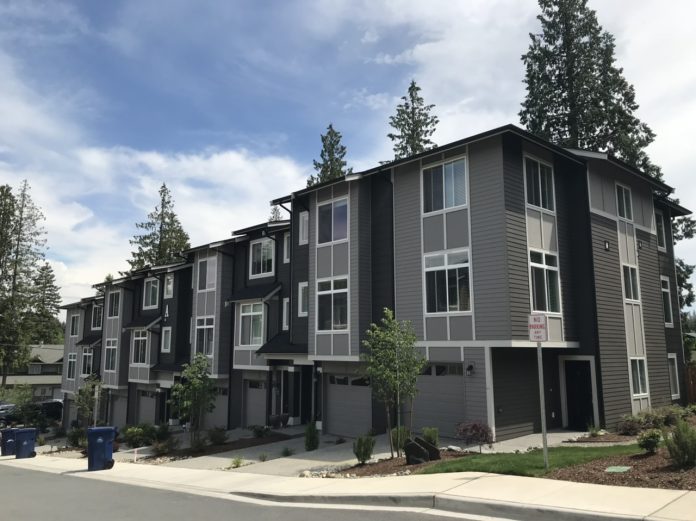In early May, the Snohomish County Council signed off on two ordinances allowing more housing in urban areas. These steps in encouraging more urban infill housing will be important as the county marches forward in developing further policies as part of its 2024 comprehensive plan update that will look out toward 2045. Unincorporated urban growth areas that the county manages are expected to see at least 86,498 more residents in the next two decades.
Ahead of the votes, Mike Pattison of the Master Builders Association of King and Snohomish Counties, testified on the benefits of both pieces of legislation.
“I know it’s been a long-time coming, a lot of work has gone into this to fine tune and refine [the legislation], and identify things that will make a difference in addressing our housing supply shortage,” Pattison said. “The modest height increases in some instances, the modestly increased density bonuses, preservation of existing housing by incentive instead of a stick, I think is very important…This will be a strong step forward in increasing supply, which is less than two weeks now and compared to a healthy supply which is six months.”
Also in his comments, Pattison noted that some leaders in the state legislature have tried to take on big missing middle housing reforms backed by Governor Jay Inslee, but regrettably stumbled in this year’s legislative session. Democrats opposed to progressive housing reform like Representatives Gerry Pollet and Tana Senn helped tank the legislation. Pattison commended the county council for taking on missing middle housing reforms despite state inaction.
Development regulation reforms in residential zones
The first ordinance approved dealt with urban residential zones in several ways:
- Increasing density bonuses allowed for Planned Residential Developments (PRDs) and townhouse developments;
- Allowing existing residential units that are retained to be exempt from density calculations;
- Allowing building heights to be increased by five feet in the R-7,200 zone (a type of urban low-density residential zone) provided some additional setbacks; and
- Authorizing townhouses to be an outright permitted use in the R-7,200 zone instead an administrative conditional use.
For density bonuses, the new ordinance introduced several interesting changes:
- In PRDs, the general density bonus was increased from 20% to 50% over the base zoning allowance in all zones where PRDs are permitted;
- In the R-7,200 zone, the density bonus for townhouses and mixed townhouse developments was also increased from 20% to 50%;
- In PRDs, lot size averaging subdivisions, R-7,200 zones, Low Density Multiple Residential (LDMR) zones, and Multiple Residential (MR) zones, density bonuses were adjusted so that they can be used with retention of existing dwelling units by exempting such dwelling units from density calculations, though with some caveats.
The additional height in R-7,200 zones allows buildings to be constructed up to 35 feet instead of just 30 feet to encourage more variety in building types, such as three-story homes with reasonable head height. By increasing the height, the county added increased setbacks from side and rear lot lines when adjacent to urban residential and rural zones. This increased setback requires buildings exceeding 30 feet in height to provide a 10-foot setback rather than a five-foot setback, except in limited circumstances.
Allowing residential development in Business Park zones
The county has a very limited number of Business Park (BP) zones and used to allow residential development in them, but that lapsed in 2017 when regulations changed. Changes adopted in May, however, re-allowed residential development in these zones for large development sites.
Under the reforms, the county is allowing residential development when located on a single site with at least 25 acres under uniform control. Residential uses permitted broadly cover most everything from single-family detached to apartments. Standalone residential and residential in mixed-use developments are subject to all MR zone development standards, including things like density limits, setbacks, and height limits.
The county has four large BP-zoned areas. Those include parcels near the airport, parcels just off of Alderwood Parkway south the Fred Meyer, parcels in the Cathcart area where the county owns quite a bit of property, and parcels just north of 164th Street SW west of Swamp Creek. The latter two areas probably have the most potential for residential development under the legislation.
What the county council said
Snohomish County Councilmembers Nate Nehring and Megan Dunn spoke in favor of the missing middle housing legislation.
“I’m hopeful this is going to encourage increased housing supply and also a greater diversity of housing types for homeownership, which is a key to economic mobility for folks in our communities,” Nehring said.
“I think this is a very progressive action and I’m glad that we got input on heights for surrounding cities so that we’re not negatively impacting the cities if they were to later annex areas,” Dunn said. “I feel it’s very compatible and also takes steps for making sure we’re not changing character of neighborhoods.”
Also in her comments, Dunn mentioned that the legislation could have gone to voters as an advisory matter, but she felt it was important for the county council to make decisions on reform, especially in light of state efforts encouraging local governments to take action on allowing more urban housing.
Dunn concluded by saying, “I think it’s important…that we’re increasing density and housing options while we’re also allowing for local source of income for other types of housing [via the new affordable housing sales tax].”
Both pieces of legislation passed unanimously with Snohomish County Councilmember Stephanie Wright absent.
Stephen is a professional urban planner in Puget Sound with a passion for sustainable, livable, and diverse cities. He is especially interested in how policies, regulations, and programs can promote positive outcomes for communities. With stints in great cities like Bellingham and Cork, Stephen currently lives in Seattle. He primarily covers land use and transportation issues and has been with The Urbanist since 2014.


